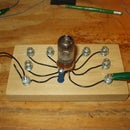Introduction: Resistor Filing and Storage System
I rebuild/refurbish tube radios and amps and build the occasional DIY project so I'm always needing various resistor values. I finally got tired of having to go to Radio Shack or place an order online every time I got a new radio. So, I bought a resistor kit. I found one on Ebay that included 50 values of 1 watt resistors that will cover most of my needs. When combined with my original stock of resistors I now have 100-125 values of resistors to store and keep track of.
No more of this dumping them all in the bottom of a draw and searching for the needle in the haystack. I needed a system for storing my resistors by value so that I can get them instantly. What I came up with works very well for me and should work for you.
Step 1: The Parts
1 or 2 boxes of plastic zip lock SNACK bags. You'll need one bag per resistor size. Be sure to get the snack bag size. They are perfect for this use. About $1 at the $1 store.
Some card stock cut to fit inside the bags
Printed labels or sharp pointed marker
A box or container just slightly wider than the bags. I found that Michael's and other crafts stores carry a nice photo storage box that's just the right size. I got one for $3 on sale so I bought two.
Step 2: Divide Your Resistors
My resistor kit came shipped in separate bags marked with the value. But I did a quick test with my ohm meter to double check and did find one pack mislabeled. Separate your resistors by value so you know what you have and start with the lowest value.
Step 3: Bagging
On one of the cards write the value of the resistor. I found some labels that have the value and the color code for standard resistors that I also put on the card. In the process of putting together this system I've almost memorized the color code with out even trying.
Put the card and the resistors in the bag and close it. Be sure to press out all of the air first, they will store better that way.
Just do this over and over until you have all of your resistors bagged and filed.
If your box is too long fill the back with another box or something so that your resistors are snug and won't move around and get out of order.
Step 4: Finally
This should make your projects go a little smoother since you won't have to spend so much time looking for parts. When you notice that you are running short on a value make a note of it and when you are low on a couple order them so you don't run out.
Hope you get a little more free time with my project.













